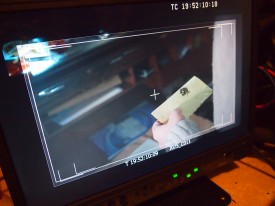
Working with editor Miguel Ferros on Stop/Eject in 2012/13 was a big eye-opener for me, demonstrating how much better my films could be if I didn’t edit them myself. It also helped me realise how little I like the isolated job of editing compared with the fun, stress and teamwork of being on set. Since then I’ve been gradually letting go of my editing work, both corporate and creative. My business card used to say ‘Director, Editor, DP’. Now it just says ‘Director, DP’.
Editing can be a thankless task, particularly in the corporate world. Once upon a time, when I had a cut I was happy with, I invited the client along to the edit suite, played it for them, then we discussed how it might be improved. But since broadband happened, clients wanted me to Dropbox the edit to them and then, rather than a creative discussion, I was typically emailed a list of instructions for changes. This is the point at which I would shut off my brain, carry out the instructions, often feeling that I was making the film worse, take the money and run.
So there’s much to be said for being in the same room as your editor. Not all the time, of course, but enough so that revisions can be made – or least discussed – collaboratively rather than imposed authoritatively.
Which is all pre-amble to saying that I travelled up to Nottingham yesterday to spend the day working with Tristan Ofield on the edit of Amelia’s Letter. He set up his Mac Mini in a darkened room in the Broadway and, after I popped out to be interviewed for the EPK, we got to work knocking the film into shape.

I hadn’t realised until then how difficult a film it must have been for Tristan to assemble: multiple time periods; intercutting scenes that were numbered separately on the page but shot together as one; a cheated geography of the cottage relative to the lake. The one advantage of editing your own film is that you know where everything is supposed to go, but Tristan had to figure it out the hard way. He’s put a lot of work into wrangling and shaping the material over the last few months.
It was a very productive day. We started at the beginning of the film and went steadily through, nipping, tucking and often completely rebuilding scenes. The film we had when we finished at 5pm was streets ahead of the one we had at 9am. We got the running time down from 15’30 to a much more festival-friendly 12 minutes, trimming most in the first few scenes to get the story going sooner. The emotional core of the film was already shining through in Tristan’s cut, but now the creepy and tense moments work nicely as well.
The next stage will be to screen the film for a test audience. This is an essential step I’ve taken with all my films since The Beacon in 2001, to make sure that the story is clear, the pacing is right and the desired emotions are coming across. For more on why test screenings are important, read my blogs about test-screening Stop/Eject and some of the problems that it highlighted.
Update: You can read Tristan’s thoughts on editing over at belowthelinefilm.blogspot.co.uk
Amelia’s Letter is written by Steven Deery and produced by Sophia Ramcharan of Stella Vision Productions. Visit the Amelia’s Letter Facebook page.